1/72 Avro Lincoln Mk II
|
KIT #: |
Kitbashed with Airfix kit |
|
PRICE: |
$ |
|
DECALS: |
See Review |
|
REVIEWER: |
Carmel J. Attard |
|
NOTES: |
|
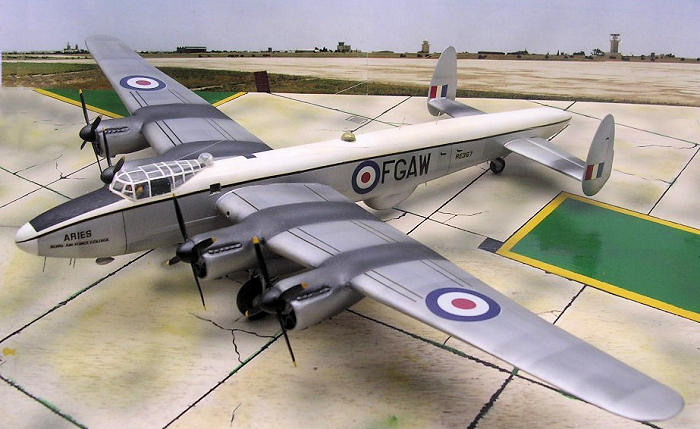
 The
Avro Lincolnian was a descendant of the Avro Lincoln bomber. The
Lincoln
came too late to enter service in WWII and was itself derived from the famous
Avro Lancaster bomber. Still the
Lincoln
had a long and distinguished career during post war years seeing active service
on a number of occasions and serving into the 1960s. It was effective, reliable
and popular with its crew and quickly gained an enviable reputation.
Lincoln
bombers often staged through
Malta
using the airfield at Luqa as a staging post during its outward journey to the
Far
East.
Often spotted in formation of three bombers and using runway 024 making a
fantastic experience watching them coming in to land one by one.
The
Avro Lincolnian was a descendant of the Avro Lincoln bomber. The
Lincoln
came too late to enter service in WWII and was itself derived from the famous
Avro Lancaster bomber. Still the
Lincoln
had a long and distinguished career during post war years seeing active service
on a number of occasions and serving into the 1960s. It was effective, reliable
and popular with its crew and quickly gained an enviable reputation.
Lincoln
bombers often staged through
Malta
using the airfield at Luqa as a staging post during its outward journey to the
Far
East.
Often spotted in formation of three bombers and using runway 024 making a
fantastic experience watching them coming in to land one by one.
The first Lincolnian built was RE367 named
Aries II and was delivered to the
Empire
Air
Navigation
School
at Shaubury on
20th
February 1947.
It was specially fitted with extra fuel tanks and rest banks and seats installed
in the sound proof fuselage. Enhanced navigational equipment included G3
compass, AP1 MkII and GPI Mk II. The aircraft also gained passenger
accommodation with oxygen and intercom to all seats and crew positions.
Externally it had extra windows and streamlined nose and tail fairing in place
of gun turrets. Fuel load included 4,615 imp gallons by addition of new tanks in
the nose. It was eventually written off in a hangar fire and replaced by
similarly modified Aries III RE369. This was transferred to the new
RAF
Flying
College
at Manby.
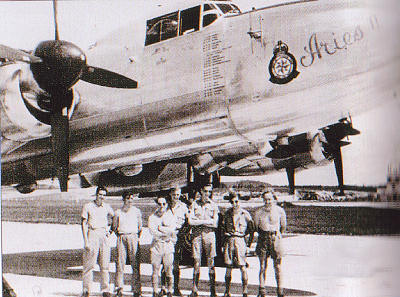 Three
radically modified Lincolnian freighters were ordered by
Paraguay.
These were converted to Type 595 standard from ex-RAF
Lincolns.
These carried a huge ventral freight pannier to carry meat, and this faired into
a new deeper nose fairing. These were completed and fully painted in Paraguayan
civil colours but the deal fell through at the last minute and the aircraft were
scrapped. Another ex-RAF b Mk II RE290 was converted by Airflight Ltd and was
used by Surrey Flying Services Ltd on the Berlin Airlift. The aircraft made 45
flights carrying fuel oil to the beleaguered city before the Russians blockade
was lifted. The aircraft was then retired and scrapped.
Three
radically modified Lincolnian freighters were ordered by
Paraguay.
These were converted to Type 595 standard from ex-RAF
Lincolns.
These carried a huge ventral freight pannier to carry meat, and this faired into
a new deeper nose fairing. These were completed and fully painted in Paraguayan
civil colours but the deal fell through at the last minute and the aircraft were
scrapped. Another ex-RAF b Mk II RE290 was converted by Airflight Ltd and was
used by Surrey Flying Services Ltd on the Berlin Airlift. The aircraft made 45
flights carrying fuel oil to the beleaguered city before the Russians blockade
was lifted. The aircraft was then retired and scrapped.
Back to the Aries II,
this replaced its predecessor Aries I that was a converted
Lancaster.
In its short career the aircraft conducted advanced navigation training and made
numerous long range flights, each recorded below the cockpit on the starboard
side. This included a host of other countries including
USA,
Canada,
Iraq,
Kenya,
Ceylon,
Burma
and
Malta.
The aircraft depicted in picture of Aries II at Luqa,
Malta, only one month before it was extensively damaged in a hangar fire.
No information provided
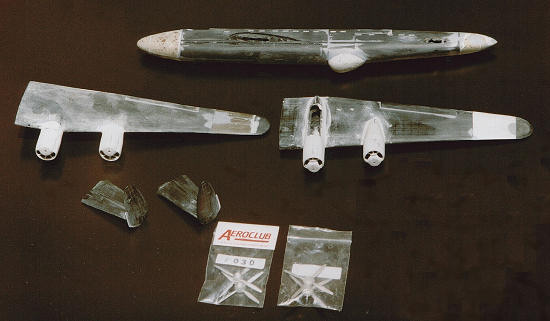 The
following listed points describe the steps taken to produce the Lincolnian from
a basic Airfix Lancaster model and vacform engine parts that came from surplus
parts from the Rareplanes C-54 scale model which was
reviewed earlier.
The
following listed points describe the steps taken to produce the Lincolnian from
a basic Airfix Lancaster model and vacform engine parts that came from surplus
parts from the Rareplanes C-54 scale model which was
reviewed earlier.
1.
Four
in number metal 4-bladed propellers were purchased from Aeroclub.
2.
Mid
fuselage turret was removed, the area blanked with putty and plastic card cut to
conform shape. Astrodome moulded from clear acetate and added to the new small
opening at same place.
3.
Assembled and fitted four in number Pickard Merlin vac form engines from the
Canadair/C54 Rareplanes kit.
4.
Extended the wing span at the wingtips area.
5.
Extended the trim tabs attached to the rudders.
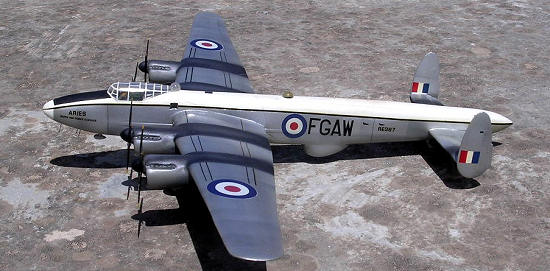 6.
Built
up and shaped under fuselage radome
using plastic card and Milliput filler.
6.
Built
up and shaped under fuselage radome
using plastic card and Milliput filler.
7.
Added
new support brackets for the main wheels.
8.
Built
a new nose and tail cone shaped out of balsa wood
9.
Altered the shape of the hubs of main wheels.
10.
Cut
two new windows
into
fuselage sides.
11.
Extended
the fuselage using inserts from another
Lancaster
fuselage. This was a surplus fuselage when I built an Avro York RAF transport
aircraft.
12.
Enlarged
the outside diameter of the main wheels.
13.
Added
air intake to starboard fuselage side from a small spare half bomb part.
14.
Blanked all the rectangular fuselage windows on the
Lancaster
fuselage.
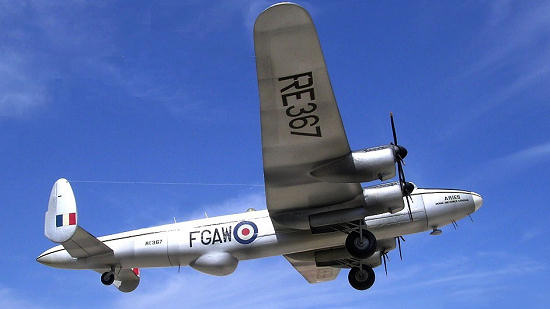 I
used local brand of Hemple silver paint for most of fuselage and wing panels
adding variations at different places using a mix of Micro matt varnish with a
little engine grey all mixed to a good proportion of silver. The upper decking
was semi matt white, a mix of 50:50 Humbrol matt and gloss white. All the decals
came from the Modeldecal range of roundels and lettering.
I
used local brand of Hemple silver paint for most of fuselage and wing panels
adding variations at different places using a mix of Micro matt varnish with a
little engine grey all mixed to a good proportion of silver. The upper decking
was semi matt white, a mix of 50:50 Humbrol matt and gloss white. All the decals
came from the Modeldecal range of roundels and lettering.
This was not a difficult conversion as it may sound but
certainly a thoughtful suggestion of what to do with a
Lancaster
kit that was built long ago and is out of place and requires to be renovated
into something for a better build.
Scale
Plans from SAM Vol 12 no4 which also provided a side view of the RE367 as used
by the
Empire
Air
Navigation
School.
Carmel J. Attard
June 2008
Copyright ModelingMadness.com.
All rights reserved. No reproduction in part or in whole without express
permission from the editor.
Back to the Main Page
Back to the Review
Index Page 2016





 6.
Built
up and shaped under fuselage radome
using plastic card and Milliput filler.
6.
Built
up and shaped under fuselage radome
using plastic card and Milliput filler. I
used local brand of Hemple silver paint for most of fuselage and wing panels
adding variations at different places using a mix of Micro matt varnish with a
little engine grey all mixed to a good proportion of silver. The upper decking
was semi matt white, a mix of 50:50 Humbrol matt and gloss white. All the decals
came from the Modeldecal range of roundels and lettering.
I
used local brand of Hemple silver paint for most of fuselage and wing panels
adding variations at different places using a mix of Micro matt varnish with a
little engine grey all mixed to a good proportion of silver. The upper decking
was semi matt white, a mix of 50:50 Humbrol matt and gloss white. All the decals
came from the Modeldecal range of roundels and lettering.